MELANCHOLIA or, The Romantic Anti-Sublime
Steven Shaviro
[Available as a Free eBook]
1. Cosmic Drama and Melodrama
Lars von Trier’s film Melancholia (2011) envisions the end of the world. The movie both opens and closes with a cosmic catastrophe. A previously unknown planet, known as Melancholia, emerges from behind the sun and smashes into the Earth. The collision obliterates us, together with everything that we know.
Despite its apocalyptic vision, however, Melancholia is not a disaster film. It refuses to present us with a grandiose and sublime spectacle of destruction. There is none of the hyperbolic devastation, and frenetically edited chaos, that we find in Hollywood disaster movies like Michael Bay’s Armageddon (1998), or Roland Emmerich’s 2012 (2009) — or, for that matter, James Cameron’s Titanic (1997). More surprisingly, perhaps, there is also none of the intimate violence and sexual extremity that we find in such recent “transgressive” European art-house films as Gaspar Noé’s Irreversible (2002), Srđan Spasojević’s A Serbian Film (2010), and von Trier’s own previous release Antichrist (2009). In this latter film, made just two years before Melancholia, von Trier overwhelms the viewer with scenes of genital mutilation — not to mention grotesque, surrealistic visions of messy animal afterbirths and hordes of women without faces.
In contrast, Melancholia is quite restrained, even as it literally depicts the end of everything. The film avoids shock tactics, and does not assault the viewer. It contains nothing transgressive or outré — or even ironic. Instead, Melancholia wears its heart on its sleeve, and expresses its bleak emotions with an even excessive sincerity. The aesthetic of Melancholia is anti-spectacular, anti-sublime, and quietly deflationary. Its mood is sad and reflective, as befits a film that gives a portrait of extreme depression. Although Melancholia envisions the complete destruction of the Earth, its action unfolds in a sort of parenthesis, between the first intimations of this destruction and its final advent.
All in all, Melancholia is best described as a kind of domestic melodrama. It is less concerned with the actual mechanisms of cosmic disaster, than with how the prospect of this disaster affects its two protagonists. These are the sisters Justine (Kirsten Dunst) and Claire (Charlotte Gainsbourg). They are young, white, and affluent. The film is mostly about their emotional lives. The first half of Melancholia is focused on Justine. It shows us, in merciless detail, her depressive breakdown in the course of her own wedding reception. The second half, in contrast, is focused on Claire. It shows her trying to cope with the knowledge that the end of the world is at hand.
In this way, even as Melancholia broadens out to narrate an event of cosmic significance, it remains claustrophobically focused upon Justine and Claire and their immediate feelings. The film moves directly, and without any mediation, from intimate melodrama to cosmological drama and back again. It connects inner personal experience with ultimate cosmic realities, skipping over whatever might lie in between. It produces a kind of short-circuit between the petty constraints of bourgeois society, on the one hand, and the massive, inhuman forces of Nature, on the other. Melancholia is both Lars von Trier’s intimate notebook on depression, and his metaphysical speculation on last things. The film, in other words, is both a new Anatomy of Melancholy, and a new Romantic Naturphilosophie.
Throughout Melancholia, we never leave the single setting of Claire’s home — or I should say, rather, the home that is owned and managed in haut bourgeois style by Claire’s husband John (Kiefer Sutherland). The place is a secluded country estate: a luxurious mansion with a large terrace and immaculately maintained lawns, plus horse stables and an eighteen-hole golf course. The property is isolated, and almost entirely self-sufficient. There’s nobody around, aside from a few highly privileged white people; the other Ninety-Nine Percent might as well not even exist. John’s estate is difficult of access, and also difficult to get away from. Early in the movie, a limousine carrying Justine and her new husband Michael (Alexander Starsgård) is too long to negotiate the hairpin turns of the road that leads to the house. They end up two hours late to their own wedding reception. This failed penetration is, of course, a harbinger of things to come. But later, on two occasions when the sisters go horseback riding, Justine’s horse Abraham repeatedly balks and refuses to cross the bridge that would take him beyond the boundary of John’s lands. And towards the end of the film, Claire finds herself unable to flee the estate — there is literally no place else for her to go. The world of Melancholia is a tiny, self-enclosed microcosm of Western white bourgeois privilege; and this microcosm is what gets destroyed at the end.
As one of many recent Western European and North American films to imagine the end of the world, Melancholia is a product of the “structure of feeling” that Mark Fisher calls capitalist realism. This is “the widespread sense that not only is capitalism the only viable political and economic system, but also that it is now impossible even to imagine a coherent alternative to it” (Fisher 2009, 2). We have all internalized Margaret Thatcher’s dictum that “There Is No Alternative” to the reign of the so-called “free market.” Anything and everything that we can imagine is immediately recuperated by the system. It is turned into a brand, and “monetized” through financial speculation. “All that is solid melts into PR” (39). We are faced with continual novelty and innovation; and yet nothing ever really changes. Somehow, the future has been exhausted: as Fisher puts it, “the future harbors only reiteration and re-permutation… nothing new can ever happen” (3). Under such conditions, Fisher says — paraphrasing both Fredric Jameson and Slavoj Žižek — “it is easier to imagine the end of the world than it is to imagine the end of capitalism” (2).
The allure of disaster movies, in an age of capitalist realism, is that they seem to offer us a way out — indeed, the only conceivable way out. Over the past few decades, endless rounds of privatization and austerity, not to mention widespread environmental degradation, have already deprived us of a future. The world of our hopes and dreams has in fact already ended: our day-to-day existence just needs to catch up with this fact. And so our only chance for release from the continuing soft disaster of our lives is for this disaster to become truly universal. If the world ends, then at least we will be freed from the rapacity of financial institutions, and from our ever-increasing burdens of debt. The cinematic spectacle of disaster is in itself intensely gratifying, as well: we see destroyed, before our very eyes, that “immense collection of commodities” after which we have always striven, upon which we have focused all our desires, and which has always ended up disappointing us.
Melancholia inverts this scenario; it gives us the other side of capitalist realism. The film withholds spectacle and refuses sublimity. It broods, rather than screams. It presents us with a deflationary, disillusioned account, both of the existing world, and of its disappearance. Disaster no longer gives us any sense of release. In von Trier’s dysphoric vision, we get as little satisfaction from the annihilation of things as we did from their existence in the first place. Instead, set as it is among the One Percent — the white, affluent few — Melancholia affords us a truly depressing realization. It shows us that these well-to-do people would rather see the whole world come to an end, than give up even the tiniest fraction of their wealth, power, and privilege.
Von Trier’s twist on the disaster scenario of capitalist realism is to take it entirely at face value. He literalizes the catastrophic deadlock of a society from which all futurity has been drained away, and from whose possibilities the many have been excluded, just so that the few may carry on with their privileged ways. From a strictly social point of view, the end of the world is a metaphor: an image of all our hopes and fears, and of our inability to imagine anything better. But by taking the prospect of disaster entirely literally, von Trier drags it beyond its social limits, and gives it a fully cosmological import. Melancholia pushes us to come to grips with what the philosopher Ray Brassier calls “the truth of extinction” (Brassier 2007, 205ff).
2. Tableaux
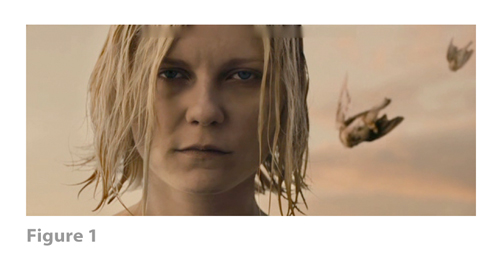
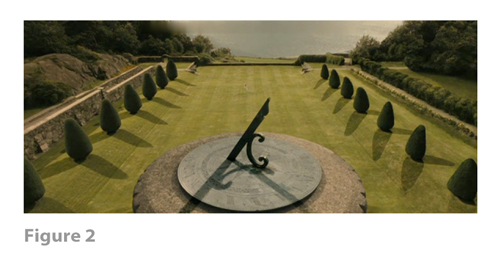
Melancholia is predominantly a narrative film; but it begins with a striking non-narrative Prologue. This is an eight-minute-long pre-credit sequence, consisting of sixteen haunting, static visual tableaux. In each shot, the camera is fixed, and things move in slow motion, or not at all. In the very first shot, Justine’s desolate face stares out at us in extreme close-up; behind her, birds fall slowly out of the sky [Figure 1, above]. The second shot [Figure 2, above] shows us an empty formal garden, reminiscent perhaps of Alain Resnais’ Last Year At Marienbad — as Manohla Dargis (2011) suggests — except with the uncanny added detail that every object is casting two shadows. In the third shot, a reproduction of Breughel’s painting Hunters in the Snow fills the screen, and begins to burn [Figure 3, below]. (Dargis 2011 points out that this painting also appears in Tarkovsky’s Solaris). In a later shot, Justine slowly raises her hands, and lightning flashes out from her fingertips [Figure 4, below]. Still later, in a shot alluding to John Everett Millais’ painting Ophelia, Justine lies motionless, floating face up in the water, wearing a wedding dress and clutching a bouquet of flowers [Figure 5, below]. Other shots seem to reference the work of contemporary photographers like Gregory Crewdson (noted by Dargis 2011 allusions of the tableaux thus range through several centuries. But overall, they seem to me most strongly to evoke the morbid hothouse atmospherics of pre-Raphaelite painting.
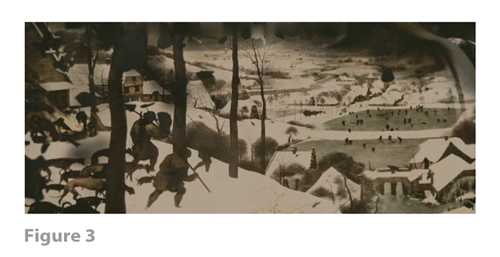
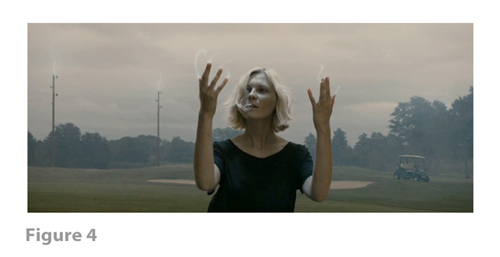
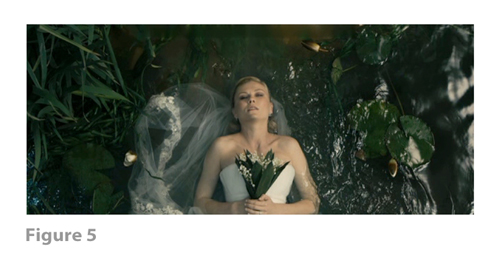
These shots — giving us our first glimpses of characters and locations that we will encounter again in the main body of the film — are interspersed with CGI visions of outer space. Rather than evoking the pre-Raphaelites, these distant and majestic tableaux seem to recall the icy infinities of Stanley Kubrick’s 2001. We see two planets suspended in the void. From one shot to the next, the spheres get closer and closer to each other. Finally, in the last shot of the sequence, the smaller planet slowly smashes into the larger one, with a bright flash, followed by the ejection of a spume of debris into the void [Figure 6, below]. At the moment of contact, the larger planet looks rather like a gigantic breast, with the smaller, impacted planet as its nipple. But whether or not we take this image as a return to the maternal, there is nothing terrifying about it. At such a distance, the planetary collision only looks beautiful. We are not overwhelmed by any sublime feelings of shock and awe. Rather, we are so far away from the disaster that we are able to regard it in a detached and aestheticized way — disinterestedly, as Kant would say. It’s as if the actual fate of the Earth scarcely concerned us at all.
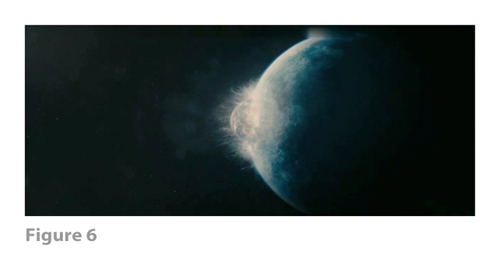
During this entire opening sequence, Wagner’s Prelude to Tristan and Isolde plays on the soundtrack. We are bathed in the ambiance of the unresolved “Tristan chord,” with its brooding, somber mood of unfulfilled longing. Together, music and images create an odd sort of churning suspension. There is no peace, no equilibrium; everything feels unstable, on edge, and out of whack. And yet, there is also no dynamism, no sense of actual movement, no hint of anything that might resolve these disturbing tensions. We are stuck, as Dargis puts it, with the “liminal quality” of a series of “in-between feelings, sensations, gestures.” Nothing gets clarified, nothing goes anywhere; the past fails to give way to the future. Instead, everything just seems to linger. The disaster is on its way, but it has not yet arrived; unless, as Maurice Blanchot would likely suggest, this not-yet, this non-advent, this suspension of time, so that the present does not pass and the future does not arrive, is itself already the disaster.
Such tension is epitomized in yet another shot from the opening sequence. Justine, wearing her wedding dress, makes her way through the forest, straining against tendrils of vegetation that wrap around her [Figure 7, below]. They are pulling her backwards, dragging against her forward motion, as if to slowly pull her down into the Earth. It’s as if Nature itself were holding Justine back, making it impossible for her to flee. She can neither escape, nor entirely submit. This visual inconclusiveness fits well with the way that the music holds back from — or indefinitely postpones — the resolution and relief of a final cadence. The world is about to be annihilated; but when there is no prospect of a future, there is also no climax, no “sense of an ending.”
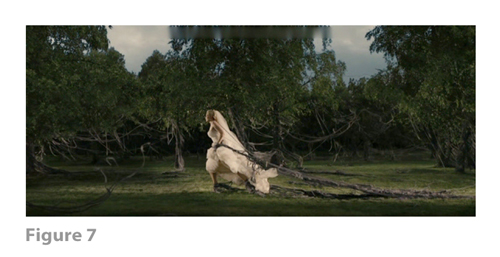
The Prelude to Tristan is not just played in the Prologue. It returns, again and again, throughout the film. Indeed, it is the only nondiegetic music that we hear in the entire course of Melancholia. And each time that we hear the Prelude, it starts all over again from the beginning. While the deeply ambivalent emotions aroused by this piece of music are never altogether abolished, they are worn down — turned into a kind of cliché — by excessive repetition. As the music critic Alex Ross (2011) complains, “von Trier dwells so relentlessly on the opening of the prelude that it turns into a kind of cloying signature tune; repetition robs the music of its capacity to surprise and seduce the listener.”
Ross’s account of how von Trier uses Wagner is not inaccurate, despite the fact that he means to disparage the film. Ross simply fails to grasp the full implications of the process that he is describing. Indeed, by dint of its sheer repetition throughout Melancholia, the Prelude becomes a maddening automatism. It is a sticking-point for the film, a moment that we return to incessantly, because it can never be surpassed. The Prelude marks what the Lacanians would call the film’s death drive: a kind of insurpassable, idiotic reiteration, or — as Žižek puts it — “the horrible fate of being caught in the endless repetitive cycle of wandering around in guilt and pain” (2006, 62). Von Trier quite deliberately empties out the Prelude, depriving it of its power “to surprise and seduce the listener.” He thereby brings out, all the more strongly, another dimension of the music: the way that it articulates an emotional turmoil which is also a kind of inertia, an inability ever to have done with things and move on. In this way, the Prelude becomes an expression, no longer of erotic longing, but rather of the unstable, and yet paradoxically unmoving, turmoil of the state of extreme depression.
The Prelude to Tristan, repeated in this way, is the sonic equivalent of — as well as the actual accompaniment to — the visual tableaux that open the film. The music builds up tension, without providing resolution or release. As Žižek says, the death drive is the “opposite” of anything like a “return to the inorganic absence of any life-tension” (Žižek 2006, 62). And indeed, for all that von Trier repeats the Prelude to Tristan, he never gives us the second half of the piece, the Liebestod (“love-death”) with which it is supposed to conclude. That is to say, we get a continual build-up of tension, but we never get the release of any sort of catharsis. It’s like bad sex: all irritation and effort, but no orgasm. Ross objects that von Trier’s version of Wagner is not “sublime.” But von Trier’s whole effort is to hollow out the sublime, and present us with a vision of world destruction that is not spectacular or stunning. We are given the prospect — or better, the tableau — of the end of the world as paralysis and impossibility, rather than as an achieved finality.
3. Post-Continuity
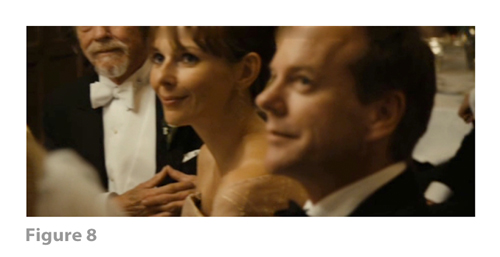
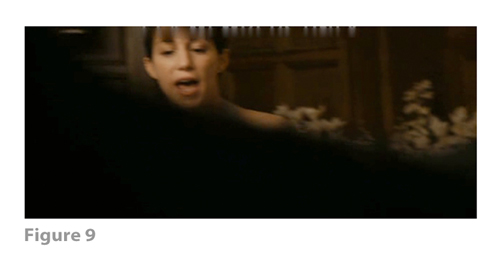
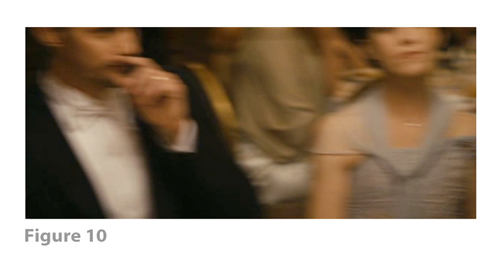
The main body of Melancholia is quite different stylistically from this opening sequence. Far from holding back to provide static, long-shot tableaux, von Trier’s camera pushes aggressively into the faces of its subjects. Everything is too close, too stiflingly intimate [Figure 8, above]. The camera is handheld, and it flutters about continually, never staying still and never steadying itself, but instead continually indulging in swish pans, readjustments of focus, and nervous reframings [Figures 9 and 10, above]. There is often no functional reason for these movements. It is as if the camera were suffering from that quintessential postmodern malady, attention deficit disorder. The editing of these sequences is also rough and abrupt, filled with jump cuts and abrupt transitions. At times, von Trier conforms to shot-reverse shot structures and other traditional continuity rules; but at other times, he casually ignores these conventions, flipping around spatial relations and scrambling perspectives. In all these ways, Melancholia is what I have elsewhere called a post-continuity film (Shaviro 2010, 123-124). No wonder von Trier’s style disconcerts so many traditionally-minded film critics; for instance, the usually astute Adrian Martin complains, in his Twitter feed, that “I tend to dislike almost every stylistic decision made by Lars von Trier… Where is the craft in this Melancholia thing ? Some of the actors are great, but nobody is being directed, it’s an amateur movie!”
Von Trier’s rough editing and restlessly moving camera give Melancholia a pseudo-documentary look and feel. But the most relevant reference point for the style of the film is still the Dogme 95 manifesto, written by von Trier in collaboration with Thomas Vinterberg and others. Evidently, von Trier no longer adheres fully to the manifesto (if he ever did). In Melancholia, he violates Dogme 95 rules in many respects: most notably with his non-diegetic use of Wagner’s Prelude, and with the special effects that allow him to depict the planet Melancholia’s approach, its reflected light, and the shadows that it casts. But von Trier still upholds one crucial principle from the manifesto: the one stating that “the camera must be handheld. Any movement or mobility attainable in the hand is permitted.” In Melancholia, aside from the Prologue, the camera’s presence is quite palpable and physical, due to the excessive “movement or mobility” of the hand holding it. Melancholia is an exceedingly haptic film (as Laura Marks might say). The camera always seems to be in the midst of the action, even though it is not contained within the diegesis, and its perspective cannot be identified with that of any protagonist.
The result of this is to blur the distinction between the action of the story, and the action of the camera that is telling the story; or between the movement of the actors within the frame, and the movement of the frame itself. In classical film narrative, space is still Newtonian: it is a fixed and rigid container, which remains the same no matter what goes on within it. But in many recent films, including Melancholia and other works by von Trier, space is Leibnizian and Einsteinian, rather than Newtownian. That is to say, it is dynamic and unstable, or relativistic and relational. We no longer experience space as a container; instead, we feel it as something in ferment, its shape continually inflected by the camera that presents it, as well as by the bodies, forces, and events that unfold within it. There are no fixed points in this space, but only vectors: moving lines of ever-varying speeds and directions.
Motionlessness is itself one of these speeds. As I have already noted, even the static tableaux of the Prologue are afflicted with an inherent restlessness and disquiet. And the end of the world, at the end of the film, is an extreme motion (the planet Melancholia rushing towards the Earth) that terminates all movement (everything dies, and the screen turns black and silent). Stasis is thus not the opposite of movement. Rather, it is the degree zero, or the limit-form, of motion: a temporary congelation, or a quivering incipience. Stillness is not excluded in Melancholia, either for the camera or for the characters. There are moments in the second half of the film when, at the worst points of her depression, Justine is very nearly catatonic, unable to bring herself to get out of bed, or even to step into a warm bath. And there are also stilled moments of strange and extreme beauty, such as might well have pleased nineteenth-century aesthetes like John Ruskin and Walter Pater. Thus, the camera is stopped in its tracks when it contemplates Justine — who finds her depression confirmed by the prospect of imminent doom — basking naked, like a pre-Raphaelite wood nymph, at night, on the bank of a stream, in the planet Melancholia’s reflected light [Figure 11, below].
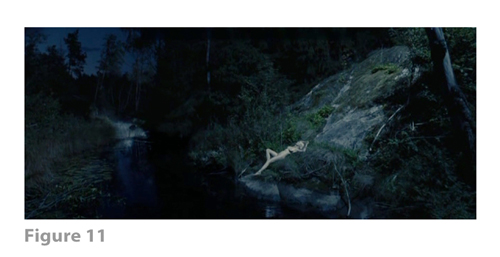
4. Depression
The camera is most agitated during Justine’s wedding reception, in the first half of the film. This is an obscenely lavish event, entirely worthy of the One Percent. But the wedding reception ostentatiously fails in its function as a social ritual. This is not because any dark familial secrets are revealed, in the manner of Thomas Vinterberg’s Dogme95 film The Celebration (1998), with which the first half of Melancholia has sometimes been compared. Rather, Justine’s wedding reception fails because — even in the absence of any scandalous revelations — it is unable to contain, and reconcile, the overt tensions and contradictions among the people whom it unites. The traditional ceremonial gestures — the toast by the best man, the speech by the groom to the bride, the cutting of the cake — all come off as hollow and awkward.
Even worse, these rituals serve as flashpoints for recurring outbursts of anger, hostility, and aggression. Justine’s estranged parents — her lackadaisical father Dexter (John Hurt) and her embittered mother Gaby (Charlotte Rampling) — resume what we gather are their old conflicts. Dexter remains determinedly (if charmingly) superficial, the better to avoid any demands upon his sympathy or attention. For her part, Gaby vents her bitterness, sparing no one. Justine fails in her efforts to reach out to both parents. Meanwhile, John omits no opportunity to remind everyone of his wealth and status, and of the fact that he is footing the bill for this expensive reception. Justine’s boss Jack (Stellan Starsgård), who is also the best man, bullies her incessantly. And the groom Michael wanders through the reception as if shell-shocked, unable to quite grasp the disaster that his own wedding has become.
Throughout the evening, Justine repeatedly tries to do what is expected of her. As she tells Claire, “I smile, and I smile, and I smile.” But she is incapable of saving the appearances. She veers back and forth between moments in which she dutifully puts on her fake smile and tries to follow the script of the ceremony, and moments in which she simply cannot take it anymore. She starts absenting herself from the festivites, and acts out in progressively more disruptive ways. First she wanders through the deserted golf course at night, and carefully squats down to piss on one of the perfectly manicured greens. Then she takes a hot bath, while all the guests are waiting for her to come down and join Michael in cutting the cake. Later, she pushes Michael away with disgust when he wants to have sex with her, and instead fucks a near-stranger on (yet again) one of the greens of the golf course. By the end of the evening, everyone has left in disgust — including Michael. The marriage is effectively over.
Justine’s acting-out might be understood as a rejection of social hypocrisies. But in fact, it is much more than that. Her actions are too extreme to be a proper response to the petty dishonesties and boringly repetitious hostilities of the wedding reception. After all, these tensions and hypocrisies are the sorts of things that are bound to happen in the course of any organized social event. They do not usually lead to over-the-top responses like Justine’s. Most of the time, we are able to take such small unpleasantnesses in stride and pass beyond them. Indeed, getting over such things and restoring social harmony — even at the price of accepting some small hypocrisies — is the very purpose of social rituals like wedding receptions. But the whole point of the film is that Justine is unable to do this. Her response is improper, disproportionate, and excessive.
Psychologically, Justine’s reactions are not willful, so much as they are compelled by extreme distress. But beyond this, Justine’s depression is ontological in scope. It cannot be characterized as just a contingent response to one particular set of circumstances. For it involves the rejection of any “particular circumstances” whatsoever. Justine’s depression marks a rupture with the social order as such: an order that cannot function without the tacit complicities and denials that are understood, and entered into, by everyone. In refusing this, Justine enters into a condition that is absolute and unqualified. Her depression is ungrounded, self-producing and self-validating. It needs no external motivation or justification. It is just what it is: an unconditioned and nonreflexive state of pure feeling.
Many people who have experienced extreme depression (a group in which I include myself) have strongly felt that von Trier gets it right in this movie. He really conveys a sense of what depression feels like. Melancholia traces the contours of depression from the inside, better than any other film I have ever seen. As Trevor Link puts it, in his beautiful essay on the film, von Trier’s “frequent use of jump cuts and changes in focus help convey this puzzling and erratic state that lacks a strong sense of direction… [von] Trier has experienced depression so deeply and gets something about it so precise that his images are entirely suffused with the stillness of the depressive state” (Link 2011).
With its careful attention to Justine’s condition, and especially with Dunst’s amazingly sensitive and nuanced performance, Melancholia refutes clinical objectivity, and instead depathologizes depression. For depression is all too often stigmatized as a moral or intellectual failure, a kind of unseemly self-indulgence — this seems to be John’s attitude towards Justine. Or else, at best, depression is understood reactively as a deficiency in relation to some supposedly normative state of mental health — this seems to be Claire’s attitude. But Melancholia suggests that both these positions are inadequate. By focusing attention so intensively upon Justine’s own emotions, it treats depression as a proper state of being, with its own integrity and ontological consistency. This is not the least of the film’s accomplishments.
I would go so far as to say that, in this regard, Melancholia is profoundly anti-Nietzschean. (The contrast could not be greater with the explicit invocation of Nietzsche in von Trier’s Antichrist). For Nietzsche has no empathy at all with the state of depression. Rather, he stigmatizes it in emphatically normative terms. Nietzsche insists upon “the futility, fallacy, absurdity, deceitfulness” of any “rebellion” against life. “A condemnation of life on the part of the living,” he writes, “is, in the end, only the symptom of a certain type of life.” Even the judgment that condemns life is itself “only a value judgment made by life”: which is to say, by a weak and decadent form of life (Twilight of the Idols, in Nietzsche 2005, 174-175). Nietzsche seeks to unmask all perspectives — even the most self-abnegating ones — as still being expressions of an underlying will to life. This universal cynicism is the inevitable counterpart of Nietzsche’s frequent, and strident, insistence upon the necessity of “cheerfulness.”
Contrary to all this, Justine’s will to life has been suspended. Her depression is a kind of positive insensibility or ataraxia, or even what Dominic Fox calls “militant dysphoria” (Fox 2009, 5 and 67). This is a state of being that no longer sees the world as its own, or itself as part of the world. As Fox puts it, “the distinction between living and dead matter collapses. The world is dead, and life appears within it as an irrational persistence, an insupportable excrescence” (70). Through its refusal to affirm or celebrate life, dysphoria subtracts itself from the will to power, and therefore from Nietzsche’s otherwise universal suspicion about motives. Depression is the one state that cannot be unmasked as just another expression of the will to power. The underlying assumption of Nietzsche’s entire critique of both morality and nihilism is that the human being, and indeed every organism, “prefers to will nothingness rather than not will” (Genealogy of Morality, in Nietzsche 2006, 68). But depression, at least in von Trier’s presentation of it, must be understood as a positive not-willing, rather than as a will to nothingness, or a destructive (and self-destructive) torsion of the will.
5. The Despair of Claire
Melancholia is structured around the contrast between Justine’s absolute dysphoria and Claire’s circumstantially-grounded despair. These are two entirely different conditions. Unlike Justine, Claire is commonsensical and businesslike. She does not suffer from depression, and she has no problem with observing social niceties. However, like the trapped housewives in more traditional melodramas, Claire seems to have no life of her own. Extremely wealthy and not needing a job, she spends all her time caring for her condescending husband John, and for their young son Leo (Cameron Spurr). And now, since Justine is so massively depressed, Claire has to take care of her as well.
Claire’s whole life is consumed by domesticity. She plays the traditional woman’s role, in patriarchal households, of mediating among everyone else’s demands, negotiating compromises, and making sure the daily chores get done. However anxious and worried she may feel, she never lets her own feelings get in the way of doing her tasks. Above all else, Claire seems obsessed with making sure that all her household arrangements are exquisitely perfect. I am tempted to say that Claire is just like Martha Stewart. But it would be more fair, and more accurate, to say that she has learned to put aside the doubts that Martha Stewart seems never to have been inflicted with in the first place. In addition, Claire is herself one of those upper-class paragons of domesticity whose values Martha Stewart channels, and markets to the masses.
Claire is almost entirely uncomplaining about her domestic duties. She always defers to John, no matter how much of a jerk he is. The only person she gets irritated with, or angry at, is Justine, who often drives her to the point of extreme exasperation. Twice in the course of the film, Claire mutters to Justine: “sometimes I hate you so much.” The first time is towards the end of the wedding reception, when it finally becomes clear that Justine has wrecked everything irreparably. The other time is shortly before the planet Melancholia hits, when Justine tells Claire that her plan for facing the end of days in a “nice” way is “a piece of shit… Why don’t we meet on the fucking toilet?” In both cases, Claire is aggrieved because Justine has failed to appreciate the sheer scope of her self-sacrificing efforts. At the end of the wedding reception, Claire is angry because she has toiled long and hard just to make Justine happy — but Justine fails to take any pleasure in the results. And when the world is about to end, Claire is crushed because Justine so savagely rejects her attempt to put aside her personal feelings of panic and despair, in a desperate effort to keep up the appearances, and maintain the values of family and civility, for one last time.
The problem, of course, is that Justine is so mired in the depths of her own depression that she is unable to reciprocate Claire’s (or anyone else’s) gestures. She cannot give an “appropriate” response to anything that happens to her. There is no common measure between her inner state and anything external to it. One might say that Justine is “withdrawn,” in the manner described by the philosopher Graham Harman: “individual objects are withdrawn into private interiors, barely able to relate at all” (Harman 2011, 36). For such indeed is the case with Justine: she is so submerged within the “private interior” of her melancholia that she is barely able to relate to other people and things at all.
Claire, for her part, is not in the least “withdrawn.” She is entirely focused upon her relations with others. Indeed, she does not seem to have a “private interior” at all. This means that, for all of her good intentions, she is only able to see Justine’s depression as a minor illness: something that can be cured with a little tender loving care. Together with this misunderstanding, Claire has a neurotic overinvestment in social propriety. She always acts “appropriately”: which is to say, in a manner fully commensurate with the external circumstances to which she is responding. Most of the time, this means that her behavior is functional and effective — which is certainly not the case for Justine. But worldly behavior is no help when the world itself is destroyed. You can’t do anything functional or effective any longer. This is why Claire breaks down. She is afflicted, not by depression or dysphoria, but by despair.
In other words, it is precisely because of her everyday competence, and her attachment to normative bourgeois family life, that Claire is unable to cope with the threat of universal destruction. I don’t mean to sound unsympathetic to Claire, or unappreciative of Gainsbourg’s deeply empathetic performance. Claire always means well, and she always tries her best. In the familiar terms of melodrama, she is more a victim than a villain: somebody who muddles through, in difficult circumstances.
But with the planet Melancholia looming in the sky like a second moon, things cannot go on in the same old way. Everyday life is suspended. The world is about to end, and Claire knows that there is nothing she can do about it. The end of the world is something exorbitant, entirely outside the realm of calculation and comprehension. It cannot be treated as just another circumstance to be dealt with, as it involves the end of all particular circumstances. Claire is in despair because she is deprived of the existential solidity that she has always been able to take for granted.
As the planet Melancholia rushes ever closer to the Earth, Claire, in a panic, tries to run away. Of course, this is absurd: things will come to an end, for her as well as for others, no matter where in the world she manages to go. But even displacement seems impossible for her. In a flurry of desperate activity, she tries to drive away from the house. But neither of the cars is working, and the golf cart is too ridiculously underpowered to take her anywhere. Then, we see Claire holding Leo in her arms, and trudging across the lawn in no particular direction — all in the midst of a freak hailstorm presumably triggered by Melancholia’s approach [Figure 12, below]. It’s after this that Claire proposes a sort of bourgeois garden party on the terrace to greet the end of the world: this is the suggestion that Justine so viciously rejects. Such is Claire’s last stab at giving some meaning to the end of the world. Finally, when all else has failed, she is reduced to helpless sobbing.
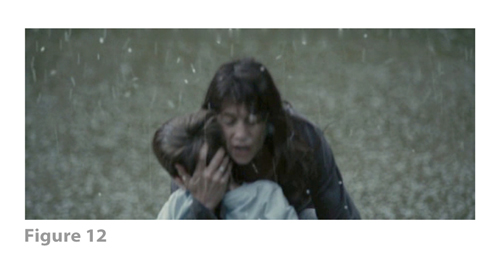
Throughout the second half of the film, Claire desperately tries to find something — anything — to do, when in fact there is nothing to be done. She looks for a purpose, in a situation that is evidently devoid of purpose. Claire will do just about anything, no matter how ridiculous, as long as it keeps up the illusion of meaningfulness and of an active will. In this respect, she is still driven by Nietzsche’s will-to-life — whereas, as we have already seen, Justine is not. Claire’s despair, we might say, is the emotional consequence of what Kant calls transcendental illusion. This is the attempt — as fallacious as it is irresistible — to take rules and principles that are valid for particular phenomena within the world, and to try to apply them instead to the world as a whole. Such an attempt can never be successful. The end of the world cannot be understood, or experienced, as an event that happens within the world. Claire’s despair is thus the result of clinging to transcendental illusion.
In contrast, Justine’s dysphoria, or lack of will, is the result of giving up on illusion altogether. This is why the approach of the planet Melancholia, which so demoralizes Claire, seems instead to energize Justine. As Justine tells Claire, from the depths of her depression, “if you think I’m afraid of the planet [Melancholia], then you’re too stupid.” Justine is beyond worrying — just as she is beyond irony, or incapable of it — because she is already so withdrawn, so distanced from the world, so entirely apart from all its values and norms. Justine is not worried about the fate of the Earth, precisely because for her the catastrophe has already happened. The end of existence holds no additional terrors; there is literally nothing left to worry about. “We don’t need to grieve for” the Earth, Justine says; “nobody will miss it.” If anything, Justine finds the prospect of extinction rather comforting; for it validates what she already feels and knows.
It might seem obvious to say that the first half of Melancholia shows us Justine’s subjective or psychological state of depression; while the second half gives us an inflated “objective correlative” of this psychological state, in the form of the planet Melancholia’s destruction of the Earth. But this would mean looking at the film backwards, and giving it a despairing interpretation instead of a properly dysphoric and deflationary one. To regard von Trier’s universal cataclysm as merely a psychological metaphor is to ignore the fact that this “correlative” is, indeed, altogether objective. It does not concern Justine in particular. Indeed, in its indifference to all human concerns, the worldwide disaster has a deeply ontological force. The planet Melancholia is not a projection of Justine’s personal melancholy. If anything, we should say the reverse: that Justine’s personal state of misery is itself a kind of interiorization — a registration on the intimate, subjective level — of the cosmic, deflationary truth of planetary extinction.
6. Anti-Modernism
In his Director’s Statement for Melancholia, von Trier says that, in making the film, he “desired to dive headlong into the abyss of German Romanticism” (von Trier 2011). Indeed, with its embrace of dysphoria rather than (and even in opposition to) despair, Melancholia is both a Romantic work, and a profoundly (and surprisingly) anti-modernist one. This is most evident in the Prologue, with its ostentatiously retro stylings; but it is generally true of the film as a whole. The Prologue overtly hearkens back to nineteenth-century Romanticism in its tone and sensibility, as well as in its explicit visual allusions, and in its use of Wagner’s Tristan. The main body of the film then explores what it might be like to uphold Romantic values in our present late modernist (or is it post-post modernist?) moment.
Melancholia is almost programmatically directed against three of the modernist aesthetic dogmas that we still largely take for granted today. First, it refuses any reduction of form to function, insisting instead upon gratuitous and nonfunctional (or even outright dysfunctional) pictorial excess. This is evident in the strained tableaux of the Prologue, as well as in the restless, excessive camera movements of the main body of the film. Second, Melancholia rejects the idea that form can be expressive in its own right, apart from (or in the absence of) some extrinsic narrative and representational content. The shots in the Prologue, like the pre-Raphaelite paintings that they mimic, are illustrative in nature — something that nearly all versions of modernism find inherently objectionable. Rather than being self-sufficient and self-referential, these images refer to a content that extends beyond them, and that they are themselves unable to contain. And third, the film flirts openly with kitsch and cliché — which is to say, with “vicarious experience and faked sensations” (as Clement Greenberg put it in his seminal, high modernist critique of kitsch). Indeed, von Trier himself confesses in an interview that Melancholia projects “an aesthetic that I would distance myself from under any other circumstances… this film is perilously close to the aesthetic of American mainstream films.” The director goes on to say that the film “consists of a lot of over-the-top clichés,” and that his use of Wagner in particular is “crass and vulgar” (Carlsen 2011).
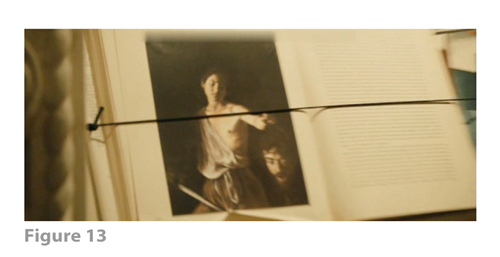
Melancholia thus exhibits precisely those features of Romantic aesthetics against which twentieth-century modernism most strongly rebelled. The film contains extraneous decoration, extraneous narration, and extraneous content — all of which refuse to be contained within a good and proper form. This rejection of modernism is itself dramatized within the narrative. At one point in the course of her wedding reception, Justine finds herself alone in John’s study. The bookcases on the wall behind her are filled with art catalogues, several of them opened to display reproductions of abstract modernist paintings. Justine frantically pulls down these reproductions, and replaces them with images of older, figurative paintings. These include Caravaggio’s David with the Head of Goliath [Figure 13, above], Karl Fredrik Hill’s Crying Deer [Figure 14, below], and Breughel’s Land of Cockaigne [Figure 15, below], as well as the Breughel painting already shown in the Prologue (Hunters in the Snow [Figure 3, above]), and Millais’ Ophelia, which was alluded to in the Prologue [Figure 16, below].
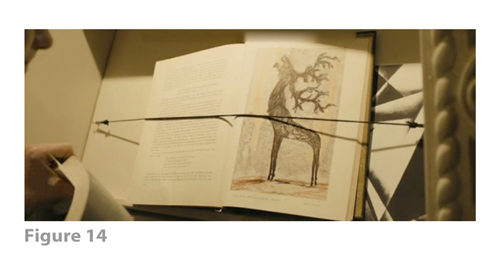
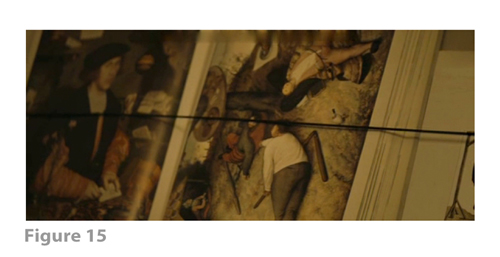
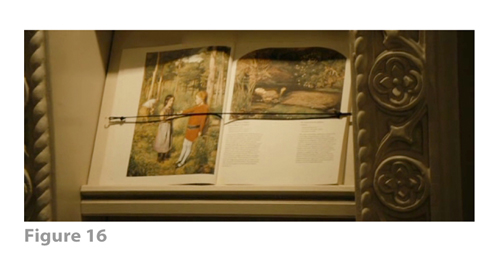
What can we make of this substitution? The scene suggests that modernist abstractions, with their rationally ordered geometric grids, are emblematic of social control and instrumental reason. They are closely aligned with John’s overweening faith in the power of scientific explanation and technological development — not to mention the power he wields with his money. These paintings also strike Justine as calling her back to social propriety. Justine has just had a painful confrontation with Claire, who has accused her of “lying to all of us,” by only pretending to enjoy the wedding reception. And so, for Justine the abstract paintings symbolize the demand that she go on with the ritual, fulfilling everyone else’s expectations with a smile, no matter how sick and disgusted she feels inside. According to Melancholia, then, modernism stands for emotional pacification, enforced optimism, and a therapeutic regimentation of the soul.
The paintings that Justine puts up in place of these abstractions belong, instead, to what Rob White calls “an artistic dark side,” or a “nightmare aesthetic,” involving “some kind of repudiation of modern outlooks” (White and Power 2011). These paintings are filled with dense, and even tasteless, pictorial detail. They portray scenes of physical violence and erotic morbidity. In sum, they show us a world that is unbalanced, opaque to rationality, and cruelly indifferent to human concerns. It’s a world in which — just as in Antichrist — “chaos reigns.” Instrumental rationality is baffled and defeated. These pre-modernist paintings express disturbing emotions that cannot be contained within modernist grids and formal patterns. They give us dangerous access to archaic and disproportionate forces. They suggest that, as Justine puts it later on in the film, “the Earth is evil… Life on earth is evil.”
Even as it explicitly hearkens back to pre-modernist visual forms, Melancholia also calls attention to the way that the canons of modernist design have become ubiquitous in contemporary culture. Films and music videos are routinely self-reflexive. Streamlined, functional furniture is present in every home. Historical and cultural allusions always come pre-packaged, with an ironic smirk already included. In short, by virtue of their very ubiquity, modernist forms have lost whatever subversive edge they might have once possessed. Instead, they are now entirely normative and naturalized. “Making it new” used to be a gesture of defiance and transformation; but today, it is little more than a marketing strategy.
Melancholia makes this situation obvious, through the way that it depicts the advertising industry. It is no accident that Justine has worked as an advertising copywriter. This is a job that comes, as her boss Jack smarmily reminds her, “with a very good salary,” at a time when “there aren’t too many jobs out there.” (Of course, nearly all the other characters in the movie are wealthy enough that they do not need to work). Even in the midst of her wedding reception, Jack pressures Justine to come up with a tagline for his latest advertising campaign. He cajoles her at first in a semi-humorous manner, which amuses the assembled wedding guests; but there can be no doubt that he is dead serious. As the reception goes on, he pushes her ever more boorishly and aggressively to provide the tagline. His demand becomes a crass joke that von Trier does not tire of repeating. Finally Justine loses her patience, and rudely tells Jack off. It’s part of her acting-out that ruins the wedding.
But what, precisely, is being advertised in Jack’s campaign? We are given no clue as to the actual nature of the product. Instead, we are shown the slick advertising image to which the tagline is supposed to be attached. This is a photo of three women splayed out artfully on their backs. They are wearing high heels, and not much else. They sprawl over an exquisitely patterned carpet. A circular table also stands on the carpet, at the upper edge of the photo and towards the left. On top of the table there are two tall glasses filled with some sort of whitish drink (milk?). One of the glasses is upright; the other lies on its side, having spilled its contents. The design, in fact, is not altogether unlike Breughel’s Land of Cockaigne — only cleaned up and smoothed out, given a slick modernist sheen. What are we to make of such an image? It could serve as an advertisement for just about anything. The sleek design, carefully calibrated to seem as if it had arisen spontaneously, is the only thing that matters. Such a form could accommodate just about any content.
Several friends with whom I have discussed Melancholia had problems with this portion of the film. Isn’t it all too facile, smug, and self-congratulatory for a European art-house director like von Trier to lampoon the advertising industry in this way, piously denouncing the vulgarities of commerce, and ridiculing products aimed at a mass audience? Don’t von Trier’s own films rely, quite extensively, upon the same visual codes as does this advertisement? Indeed they do. But I do not think that von Trier is unaware of this. His own complicity with the aesthetic that he mocks so savagely, and with the world that produces such an aesthetic, is precisely the point. The advertisement works to demonstrate the ubiquity, banality, and normativity today of modernist design and modernist reflexivity. These have general currency across all levels of culture. But they especially signify the values and possessions of the affluent Western ruling class: the One Percent to which the film’s characters belong, and who also compose its most likely (and intended) audience. Understood in this way, Melancholia raises crucial questions both about von Trier’s own aesthetic, and more generally about “taste” — taking this term both in Kant’s sense (involving a reflective judgment, not grounded in concepts) and in Pierre Bourdieu’s sense (involving class distinctions and the possession of so-called “cultural capital”).
That is to say, von Trier himself is very much of a modernist, and thereby an adherent of all the values that he criticizes in Melancholia. His work is filled with alienation-effects, carefully crafted formal patterns, and nasty ironies, not to mention cinematography worthy of the most sumptuous television commercials, . The anti-modernism of Melancholia thus necessarily cuts against the aesthetic strategies of nearly all of von Trier’s earlier work. As Amy Taubin puts it, “absent [from Melancholia] are the usual von Trier double crosses, slippery send-ups and self-satire, empty ‘Brechtian’ distancing devices, and rampant misogyny.” Taubin adds that, “as a result [Melancholia] is the first film by the director that I haven’t loathed” (Taubin 2011).
Above all, von Trier’s own modernism is expressed in his continual attempts to create shock and scandal. Melancholia is the only of his films not to display what Taubin calls his “compulsive épater les bourgeois streak” (Taubin 2011). It often feels to me as if von Trier were stuck in the phase of adolescent boyhood. Or else, perhaps, he is caught in the grip of a compulsion to repeat the primal scene of early-twentieth-century modernism’s confrontations with outraged audiences. Von Trier’s own efforts at this sort of provocation range from the child killings and heavy-handed self-reflexive ironies of The Element of Crime (1984), through the enacted social provocations of The Idiots (1998), the cruelties of Dancer in the Dark (2000), and the Brechtian distanciation tactics and “political correctness”-baiting of Dogville (2003) and Manderlay (2005), all the way to the genital mutilations in Antichrist. They might also be said to include such deliberately irritating formal experiments as the deployment of hundreds of video cameras to capture the musical numbers in Dancer in the Dark from multiple angles, and the use of computerized motion control of the camera in The Boss of It All (2006).
Melancholia is just about the only one of von Trier’s films that does not engage in any such mean-spirited audience-baiting. As the director himself puts it in an interview, “Melancholia is the least naughty film I ever did. No clitorises are cut off” (Carlsen 2011). Instead, von Trier apparently saved his urge to be “naughty” for the post-screening press conference at Cannes, after the film’s premiere, in the course of which he notoriously held forth on his deep and empathetic understanding of Hitler, and his attraction to Nazi aesthetics. In this way, he managed both (modernistically) to be as scandalous as possible, and also (anti-modernistically) to signal his film’s roots in German romanticism — of which Nazism is evidently a descendant.
In contrast to his usually arrogant and self-aggrandizing statements about his own films, von Trier seems almost embarrassed by Melancholia. He is evidently disconcerted by having to make do without his usual self-defenses of smirking irony and self-conscious disavowal. As von Trier quite remarkably writes in his Director’s Statement: “This is cream on cream. A women’s film! I feel ready to reject the film like a wrongly transplanted organ” (von Trier 2011). Is the Romanticism of Melancholia, he goes on to ask, “not just another way of expressing defeat? Defeat to the lowest of cinematic common denominators? Romance is abused in all sorts of endlessly dull ways in mainstream products… I am confused now and feel guilty. What have I done?” (von Trier 2011).
The most powerfully relevant phrase here is “women’s film.” Melancholia also cuts against modernist dogma by the way that it overtly presents itself as a melodrama, or a “women’s picture.” Throughout the history of film, the problem with melodrama has always been what we might call its tendential anti-modernism. The canons of modernist criticism reject melodrama for a number of reasons. It wallows in unearned and excessive emotions. It is mawkishly sentimental rather than truly tragic, and histrionic rather than sublime. It traffics in cliché, instead of rising to the level of authentic expression. It deals with trivial domestic situations, rather than with deeply meaningful and universal ones. All these objections, of course, are not unconnected with the fact that melodrama generally centers on female protagonists, and is traditionally addressed to female audiences.
The aesthetic ill repute of melodrama is something that still persists today — despite major critical revaluations of the genre, especially by feminists, over the course of the last thirty years. This ill repute accounts for why we are still unable to view the melodramas of such great modernist directors as Sirk, Fassbinder, and Almodóvar, as well as von Trier, without considerable ambivalence. These directors are all brilliant ironists; and we cannot stop ourselves from thinking that their vertiginous descents into kitsch, and their self-conscious deployments of clichés, are meant to be ironic or parodic. And yet, the melodramas of these directors access a realm of extreme emotion that lies beyond irony — and arguably, beyond modernist values as well. Von Trier’s own uneasiness with Melancholia may well stem from the fact that — for perhaps the only time in his entire career — he has made a film that is non-ironic, heartfelt, and sincere.
7. Gender
As an explicit “women’s picture,” Melancholia reconfigures the gender patterns of von Trier’s previous films. Most of these are centered on female protagonists, who stand in, more or less, for the director himself. However, there is a deep ambivalence in the way that von Trier “identifies” with his female protagonists. He tends to present women characters who suffer deeply; and he dwells on their suffering and abjection with a kind of delectatio morosa. The most obvious examples of this are Bess (Emily Watson) in Breaking the Waves (1996), and Selma (Björk) in Dancer in the Dark. Both of these characters are portrayed as exceedingly naive and innocent, and both are made to endure hideous fates. Bess prostitutes and abases herself, as a sacrifice to God, in exchange for the restoration of her husband’s health. Selma finds her good will abused by everyone; in the course of the film, she goes blind, has everything stolen from her, and is eventually put to death for a murder that she did not commit.
In both films, von Trier’s relation to his characters (and also, it would seem, to the actresses who play them) is at once masochistic and sadistic. The films are deeply empathetic, and invite us into a deliriously masochistic identification with Bess and Selma in their abjection. But at the same time, these female characters are so utterly passive in their misery and victimization, and their suffering is so excessive, as to suggest a certain sadistic jouissance in the process of tormenting them. That is to say, von Trier seems to receive what Slavoj Žižek calls “obscene surplus-enjoyment” from the very act of inflicting all this pain upon the characters — and also upon the actresses that play them. And this sadistic enjoyment is communicated in turn to us, as we watch the film.
Carol Clover argues, in her brilliant reading of Michael Powell’s Peeping Tom, that the male protagonist’s sadism as a filmmaker works in the service of his masochism as a filmviewer (Clover 1993, 168-181). Throughout the movie, he kills women while filming them, thus equating photographic objectification with murder. But his aim in doing this is to make a “perfect film”: one in which he can identify absolutely, as a spectator, with the pain, suffering, and death of the women on the screen. It seems to me that many of von Trier’s films give us, instead, the inverse of this schema: masochistic identification with suffering female protagonists serves as an alibi for, and an enabler of, the director’s tormenting of them.
Dogville offers an interesting twist on this pattern. The main character, Grace (Nicole Kidman), is reminiscent of Bess and Selma in the way that she is viciously abused, throughout the film, by the townspeople with whom she has taken refuge. But at the very end of the film, Grace is given absolute power over the town; she revenges herself by remorselessly killing everyone in it. The female character who has masochistically absorbed all the pain and humiliation becomes the point of identification for the violent, sadistic exertion of power as well. It turns out, however, that Grace first came to the town in an effort to escape her gangster father; and it is the father’s return that puts the town under her control. In this way, the film remains within the patriarchal order, with women consigned to victimization and power coded as male.
Von Trier’s aesthetic of victimization goes together with a stereotypical dualism, in which men are associated with activity and reason, and women with passivity and emotion. This dualism is pushed to its starkest extreme in Antichrist, which pits the condescending rationalism of the male protagonist, identified only as “He” (Willem Dafoe) against the suffering and stubborn resistance of the female protagonist, similarly identified only as “She” (Charlotte Gainsbourg). The film begins with an ironic primal scene: in an exquisitely photographed opening sequence, with an aria from Handel’s Rinaldo playing on the soundtrack, the couple’s toddler son crawls out of his bedroom window and falls to his death, even as his parents are having sex. Gainsbourg’s character is traumatized by the event. Dafoe’s character tries to pull her out of her misery by engaging in an aggressive program of psychotherapy. His rationalistic insistence that life must go on only serves to aggravate her dejection and sense of survivor’s guilt.
Dafoe’s character in Antichrist is one of the most aggravating figures I have ever encountered in the movies. The more he analyzes Gainsbourg’s character, trying to restore her to reason, the more clueless he becomes as to her actual feelings. The more he accuses her of internalizing misogynistic stereotypes about women, the more determined she becomes to affirm these stereotypes, and throw them back in his face. The therapeutic efforts of Dafoe’s character only serve to push Gainsbourg’s character over the edge, and precipitate the film’s violent catastrophe. Dafoe’s embodiment of Reason is severly punished — as male arrogance so often is in horror films — for its presumptuousness and pretense to mastery.
In spite of this, however, Dafoe’s character survives to the end of the film, while Gainsbourg’s character does not. This is because the rationalist “He” offers us the only perspective from which it is possible to witness the outburst of incomprehensible “feminine” excess. Gainsbourg’s character, in opposition to Dafoe’s rationalistic one, embodies the chaos, indifference, cruelty, and “evil” of Nature. This ostensibly “feminine” realm exists entirely in and for itself, beyond any possibility of participation, let alone identification. Feminine Nature is a kind of “all” — or, more precisely, a Lacanian “non-All” or a Schellingesque “Unground” — that cannot be grasped by any finite point of view. However, this does not mean that “masculine” rationality is abolished. Rather, it is maintained, in its very stupidity and inadequacy, as a bulwark against complete dissolution into the monstrous-feminine. I think that this impasse is revealingly symptomatic. In Antichrist, von Trier’s gender coding — not to mention his striving for sublimity and shock, and his continuing investment in a Nietzschean, perspectivist will-to-power metaphysics — gets in the way of his attempt to elaborate a full-fledged, and pessimistic, Romantic cosmology.
In Melancholia, however, male rationality is far less powerful and imposing than it was in Antichrist. John and Jack, the two “alpha-male” characters, are both unmasked as impotent impostors. Justine has no difficulty dismissing her boss Jack as “a despicable, power-hungry little man.” Jack is left speechless by this accusation; all he can do in response is to angrily smash a dinner plate — and even this takes him two tries. Similarly, Claire’s husband John, despite all his bluster and self-importance, is really just a straw man. For all his overbearing arrogance, he never seems to actually accomplish anything. He mutters complaints at Claire’s household management, but ends up going along with her decisions anyway. At one point in the course of the wedding reception, he furiously orders Gaby to leave the house. He grabs her luggage, and ostentatiously throws it out on the front lawn. But a moment later, a servant comes along to gather the luggage and bring it back inside.
Kiefer Sutherland, who plays John, is best known for his performance as the tough, pragmatic secret agent Jack Bauer, who has no qualms about torturing captives, in the TV series 24. But in Melancholia, Sutherland hollows out this role, implying that masculine power and authority is little more than empty pretense. Although John incessantly reminds everyone both of his immense wealth and of his scientific acumen, he ends up being little more than a minor irritant. He is thrilled to watch the “wonderful planet” Melancholia through his telescope; he says that its “fly-by” will be “the most amazing experience we will have in our lives.” He repeatedly assures everyone, on the basis of the authority of “real scientists,” that they have nothing to fear from the planet’s approach. And when Melancholia seems to have passed by without incident, he offers up a toast “to life.” But the moment it becomes evident that Melancholia will in fact return, and crash into the Earth, John kills himself offscreen and disappears from the film. In Melanchola — unlike Antichrist and most of von Trier’s previous films — patriarchal authority no longer matters. And there is no reason for us to lament this “decline of symbolic efficiency” (as Žižek would call it).
As Melancholia devalues male authority, it also presents its female characters in a way that is quite different from von Trier’s earlier films. Melancholia breaks away from von Trier’s usual scenarios of abject victimization — and thereby also from the double bind of complementary masochistic and sadistic forms of identification. Although the name “Justine” is taken from the Marquis de Sade’s ever-naive-and-innocent eternal victim, von Trier’s Justine is no longer such a victim. Her suffering is largely self-inflicted, in the sense that it is intrinsic to her being, rather than imposed upon her from the outside. Justine’s melancholia expresses a violent rebellion against social norms — rather than being the result of subjection to these norms. All this makes for a sharp contrast with the ways that Bess and Selma are traditional melodramatic female victims, who suffer both from the imposition of patriarchal power, and from an elaborate series of plot contrivances cruelly arranged by the director. In this way, Melancholia reverses the usual trajectory of melodrama: Justine is offered, and willfully rejects, the very “happiness” for which traditional heroines of melodrama are always unsuccessfully striving.
Melancholia replaces the stark, violent male/female opposition of Antichrist with a far more ambiguous relation between the two main female characters. For all the contrast between Justine and Claire, they cannot really be described as opposites. Their conflict does not take the form of a duality, or a dialectical contradiction. Claire never ventures beyond the limits of bourgeois “common sense”; but she is not an overweening rationalist in the manner of her husband (let alone in that of Dafoe’s character in Antichrist). Claire doesn’t understand Justine’s situation, but she does her best to accomodate her. As for Justine, her depression places her in a position that is not in opposition to anything, so much as it is radically apart. Justine is separated both from human society, and from Nature as the not-All or Unground. Justine is a lucid witness of Nature’s indifference; but she is not its embodiment. She cannot be identified with Nature-as-evil, in the way that Gainsbourg’s character is in Antichrist. Thanks to her radical disillusionment, Justine just sees things as they actually are, when separated from our all-too-human perspective.
In Melancholia, then, von Trier abandons his previous gender dichotomies; he no longer presents his female protagonist either as a helpless sufferer (the victimized-feminine), or as the embodiment of “evil” (the monstrous-feminine). This shift allows him to envision the end of the world, without resorting to the brutal theatrics of sublime spectacle found in Antichrist and his earlier movies. Melancholia presents a deflationary vision of “the truth of extinction”; and it makes us aware of a universe that is not centered upon, or necessarily correlated with, humankind. In this way, it can rightly be described as a “speculative realist” film.
8. The Truth of Extinction
Writing on what he calls “the horror of philosophy,” Eugene Thacker distinguishes between three dimensions of the world. First, there is the world-for-us, which is “the world in which we live.” Second, there is the world-in-itself, or the world as it exists apart from us. And third, there is what Thacker calls the world-without-us, a “spectral and speculative world” that exists at the limits of our thought. The first two worlds are familiar to us, as they are dialectically interrelated. The world-in-itself is independent from us; but we are always working to transform it into yet more of the world-for-us. This is what Hegel calls “the labor of the negative”; in more contemporary terms, we can say that this is the work of science and technology (Thacker 2011, 4-5).
But the world-in-itself is never entirely subsumed by such transformations. We are continually reminded of the world’s autonomy from us; most notably, Thacker says, “in the form of natural disasters,” and in long-term processes such as climate change. These events and processes seem to elude all our efforts to grasp them and control them. Whatever their empirical status, they seem to have a more-than-empirical force. Like Kantian transcendental conditions, they cannot be experienced in themselves, but they define and delimit what we are able to experience. But where Kantian transcendentals are positive and necessary conditions, generated by our minds, these limit-conditions are entirely negative and contingent ones, and utterly alien to our own thought. The “enigmatic concept” of the world-without-us points to a reality that is actively defined by “the subtraction of the human from the world.” This reality has withdrawn from us, and dispensed with us altogether. We often attempt to grasp the world-without-us through concepts like Hegel’s “bad infinity,” Sartre’s “practico-inert,” Lacan’s impossible Real, and Žižek’s “remainder.” But such concepts are only of limited value, because they remain all-too-human ones. As Thacker says, they still “attempt to put things in human terms, in the terms of the world-for-us.” The world-without-us, however, is precisely indifferent to all such formulations (Thacker 2011, 4-5).
In Melancholia, Claire is concerned with the world-for-us. As a figure from melodrama, she is entirely confined to the domestic sphere; even her dreams and desires do not extend beyond this sphere. John, as the ostensible man of action, with his scientific hobbies and his telescope, would seem to be concerned with the world-in-itself. At the very least, he pretends to such a concern, with his pronouncements about the “wonderful planet” Melancholia, and his assurances that its passage will leave the Earth unscathed. Justine, however, in her melancholic withdrawal from both of these worlds, is attuned instead to the deep enigmas of the world-without-us.
Justine’s position as a witness to a world from which we have been subtracted can only be described paradoxically. She has a strange sort of access, we might say, to that which remains forever beyond access. She envisages her own exclusion from any possible envisagement. She sees and feels what obliterates her very ability to see and feel. In apprehending the world outside of its relation to us, and outside of all the categories that we impose upon it, Justine makes contact — affectively, if not epistemologically — with what the philosopher Quentin Meillassoux calls “the great outdoors, the absolute outside.” This is a realm of being “which [is] not relative to us, and which [is] given as indifferent to its own givenness to be what it is, existing in itself regardless of whether we are thinking of it or not” (Meillassoux 2008, 7).
This world-without-us, or absolute outside, does not conform to human concepts, or to any sort of humanly-imposed order. As the philosopher Ray Brassier puts it, there is an irreducible “gap between conceptual identity and non-conceptual difference — between what our concept of the object is and what the object is in itself” (Brassier 2010, 55). Arguing from this gap, Meillassoux enunciates a principle “of the necessity of contingency, or in other words, of the omnipotence of chaos” (Meillassoux 2008, 71). The inhuman truth is that sheer contingency is the only necessity of the absolute outside. That is to say, it is paradoxically necessary that nothing whatsoever can be necessary. Anything can “change at any moment for no reason whatsoever,” Meillassoux says (Meillassxou 2008, 83).
In Melancholia, as in Antichrist before it, such a principle of chaos is fundamental. In Antichrist, we are told this directly. Dafoe’s character encounters a snarling fox that seems to be consuming its own entrails. The fox turns to him, and declares, in stentorian tones, that “chaos reigns.” Melancholia is far less explicit; but Justine is clearly concerned with the chaos, or the contingency and ungroundedness, of Nature. Justine’s is not a voice, however, that emerges from the feral abyss as the fox’s does. Rather, when Justine tells Claire that she “know[s] things,” she speaks in a tone that is filled with sadness. Her voice quivers, and her lips tremble. She is on the verge of breaking down entirely; in fact, she manages not to break down, but only just barely. Dunst’s performance as Justine shows us what it feels like to know that “life on Earth is evil,” and that — as Justine also tells Claire — “we’re alone. Life exists only on Earth. And not for long.” Justine speaks an inhuman, impersonal truth; and she speaks it without regret. But she can only speak this truth at a distance: out of her own disillusionment, her own bereavement, and her own apartness. There is no objectivity here, but only a certain modulation of affect. Even as Justine speaks a universal truth, she remains a singular being who does not, and cannot, attain (or identify with) the universal.
Von Trier’s vision of catastrophe in Melancholia may be compared with the way that Ray Brassier expounds what he calls “the truth of extinction”:
Sooner or later both life and mind will have to reckon with the disintegration of the ultimate horizon, when, roughly one trillion, trillion, trillion (101728) years from now, the accelerating expansion of the universe will have disintegrated the fabric of matter itself, terminating the possibility of embodiment. Every star in the universe will have burnt out, plunging the cosmos into a state of absolute darkness and leaving behind nothing but spent husks of collapsed matter. All free matter, whether on planetary surfaces or in interstellar space, will have decayed, eradicating any remnants of life based in protons and chemistry, and erasing every vestige of sentience — irrespective of its physical basis. (Brassier 2007, 228)
Brassier argues that scientific rationality, or Enlightenment, inevitably leads us to this understanding of eventual nothingness. Science radically separates truth from meaning. Instead of striving to give meaning to existence, we are now able “to understand the meaninglessness of existence.” In other words, science discovers truths about the world that are no longer “comprehensible in narrative terms.” These truths contradict “our psychological need for stories that unfold from beginning, through crisis, to ultimate resolution” (Brassier 2011). Finally, science discovers that all human activity, including its own, will come to an end. Scientific reason thus culminates in the discovery of its own futility, and in the knowledge of its ultimate annihilation. Reason corrodes the very basis of its own articulation.
It is important to note that this is not just a question of finitude, that great concern of so much modern (and modernist) philosophy. The point is not (or not only) that I am going to die. It is also that I cannot assume this death. I cannot make it into my “ownmost potentiality of being” as Heidegger suggests (Heidegger 1996, 243; 263 in the German text). And I cannot embrace and affirm it by celebrating, as Nietzsche urges me to do, “the eternal joy in becoming, — the joy that includes even the eternal joy in negating” (Nietzsche 2005, 228). The trauma of our annihilation, Brassier says, “is neither a possibility towards which actual existence could orient itself, nor a given datum from which future existence could proceed” (Brassier 2007, 230).
In other words, the truth of extinction is not a truth for us, because it destroys the very possibility of there being anything at all “for us.” We cannot take up or recuperate this death with which we have been infected, and which is already silently at work within us. Life and sentience have already been emptied out by the prospect of their own inevitable obliteration. When we grasp the truth of extinction in its full measure, Brassier says, we are obliged to comprehend that “everything is dead already… the solar catastrophe needs to be grasped as something that has already happened; as the aboriginal trauma driving the history of terrestrial life as an elaborately circuitous detour from stellar death” (Brassier 2007, 223).
There is a strange chiasmus between Brassier’s radical nihilism and von Trier’s cosmic pessimism. Brassier explicitly celebrates the way that scientific rationality “weans itself from the narrative structures that continue to prevail in theology and theologically inflected metaphysics… Human rationality has gradually abandoned mythology, which is basically the interpretation of reality in narrative terms” (Brassier 2011). For Brassier, myth and narrative work to reassure us of the positive meaning of life and of our place in the cosmos, whereas scientific rationality disabuses us of these illusions, and leads us to the philosophical “truth of extinction.”
Conversely, von Trier’s contempt for scientific rationality is evident throughout Melancholia, especially in his portrayal of the character of John. In Melancholia, it is scientific rationality that gives us false assurances of meaningfulness and of the possibility of survival; while it is an affective narrative that drives home the truth of meaninglessness, and of extinction. Justine arrives non-rationally, through the knowledge that comes from her depression — and also, we might say, through the affective and cinematic means deployed by von Trier — at the thought that for Brassier is the culmination of Enlightenment rationality.
Nonetheless, Brassier and von Trier are united at least in one respect. For both of them, the “truth of extinction” is not — or at least, is not just — a metaphor. It must be taken literally. For Brassier, the overwhelming literalness of “the truth of extinction” is precisely the reason why it cannot be recuperated as a correlate of our thought. “Extinction is real yet not empirical, since it is not of the order of experience… [T]he subject of philosophy must also recognize that he or she is already dead” (Brassier 2007, 238-239). The literalness of extinction means that it is not an event that we can pass through by experiencing it, but rather the unavoidable transcendental condition of whatever events we do happen to experience.
For his part, von Trier underlines the literalness of annihilation — the way that it has in the deepest sense already happened — by making it imminent, bringing it into our present moment as what is about to happen. In Melancholia, the prospect of extinction has to be faced here and now. We no longer need to wait five billion years for the Sun to burn out, or trillions of years for the final disintegration of all matter. There is no portrayal of widespread destruction in Melancholia, because the film ends the moment that the world does. Catastrophe goes unrepresented, because it literally, actually happens, in the diegetic world of the film, and in that way marks the absolute limit of diegetic representation.
And this is what makes Melancholia so powerful an expression of what I am calling “the Romantic anti-sublime.” Von Trier’s scenario of cosmic obliteration is not sublime, precisely because it is so determinedly literal. It works in such a way as to short-circuit all metaphor. Remember that the sublime, in Kant’s definitive account, is necessarily metaphorical. For it is by a kind of figural transference, or transmutation, that scenes of might and immensity in the natural world arouse the mind to a sense of its own greatness. In the sublime, we transform actual catastrophe into a figuration of our own power. “Provided we are in a safe place,” Kant quite carefully says, visions of violence and destruction can work to “raise the soul’s fortitude above its usual middle range and allow us to discover in ourselves an ability to resist which is of quite a different kind, and which gives us the courage to believe that we could be a match for nature’s seeming omnipotence” (Kant 1987, 120; Ak 261 in the German text).
In a certain sense, of course, Kant’s definition does apply to Melancholia, as it does by necessity to any work of art whose events I experience vicariously (as a “spectator”). But although I am indeed “in a safe place” when I watch Melancholia on one or another screen, the film does not inspire me to thoughts of the soul’s “omnipotence.” Rather, the sublime process of metaphorical transference is undermined by the flat literalness of the catastrophe toward which von Trier points me. Or, as Trevor Link puts it, in the film’s images “the truth of the world as imagined or feared by the depressed mind is made real, finally, rather than continuing to plague him or her as a terrifyingly palpable, yet elusive, phantasm” (Link 2011). A phantasm made real: this is the process of actualization, by means of which figuration is erased, and potentiality is reduced to definiteness and determination. The wave function collapses. No metaphor can survive being taken literally.
If Melancholia is anti-sublime — and anti-modernist as well — this means above all that its vision of extinction is deeply, and designedly, disappointing. The film deprives me of everything that I would be offered by the sublime. It does not allow me to discover an “ability to resist” within myself. It prevents me from developing any sort of recuperative self-regard. Its underwhelming presentation of the end of the world frustrates my narcissistic fantasies of universal devastation. The film even denies me the pleasures of Nietzschean “active nihilism,” by withholding the anticipated spectacle of massive destruction. In all these ways, Melancholia is not sublime, but beautiful. It offers a strange beauty that is altogether indifferent to me. I can only enjoy this beauty aesthetically, which is to say disinterestedly; this means that I must enjoy it, as it were, in spite of myself. In this way, von Trier’s pessimistic aestheticism hearkens back to Schopenhauer, who wrote that “the apprehension of beauty on the part of the subject involves a complete suppression of the will” (Schopenhauer 2007, 54).
9. The Magic Cave
At the very end of Melancholia, Justine bestirs herself. Though her facial expressions show us that she is still dysphoric and stricken, she nevertheless tries to comfort her nephew Leo. (We are not told Leo’s age, but he appears to me to be about 7 or 8 years old). Leo tells Justine that he is afraid. His father had warned him that, should the planet Melancholia return, there would be “nothing to do… nowhere to hide.” This is of course literally true. But the words of the father resonate harshly for the child, all the more so in the father’s absence. At this point, John has already killed himself; but Leo probably hasn’t been told what happened. In any case, the boy is not old enough to really understand the implications of universal extinction.
In the face of this blockage, Justine offers Leo an exception — a kind of Lacanian, “feminine” supplement — to his father’s seemingly definitive judgment. She tells Leo that his father has forgotten something: “he’s forgotten about the magic cave.” Leo is immediately entranced. For, in the course of the film, he has already, several times, asked “Aunt Steelbreaker” — as he likes to call Justine — when they will be able to “build caves together.” She has answered, from the depths of her depression, that they will surely do this later, but not now.
If Justine and Leo seem unable to find a time to play together, this is because they experience time so differently. Justine feels as if time has already effectively ended; and yet she is forced to endure, to continue to live, the absence of a future. Leo, in contrast, lives in a time that is all future: a time of excited anticipation and continual deferral. He clings to his expectations of all the things that have been promised him for later. These two time schemes are incompatible; they can only come together at the very end of the world, at that unthinkable, unrepresentable moment when “the lonely hour of the last instance” (as Louis Althusser calls it — 2006, 113) finally arrives.
Leo’s nickname for Justine, “Aunt Steelbreaker,” is never explained to us. (“Steelbreaker” is the name of an “iron giant and fearsome general” in World of Warcraft; I do not know if this is relevant: World of Warcraft Wiki). But the name suggests heroism, adventure, and unbroken resolve. Perhaps the “Steelbreaker” is somebody who can shatter or liquefy metal, pushing through even the hardest and most rigid (phallic?) barriers. As for the “magic cave,” it seems to imply a womb-like, or “feminine,” protective space. Leo evidently feels safe and comfortable when he gets the chance to “build caves” with his aunt.
Justine offers Leo both excitement and protection — things that he cannot quite get from his mother. For Claire is overly down-to-earth at the best of times; and now that things are bad, she is entirely unable to function. In any case, there seems to be a kind of complicity between Justine and Leo. It bespeaks a long and deep connection between them, most likely dating back to Leo’s earliest childhood. Leo trusts Justine, and has faith in her; he simply accepts her, as none of the adults do. As for Justine, she makes up consoling fictions in order to please and reassure Leo. This is something that she absolutely refuses to do for herself, let alone for any of the other adults.
In an interview, von Trier explains that “my analyst told me that melancholics will be more level-headed than ordinary people in a disastrous situation, partly because they can say: ‘What did I tell you?’… but also because they have nothing to lose.” Claire “has something to lose,” von Trier says; “for instance, a child.” Claire herself, he adds, “is not longing for anything”; rather, she “appreciates” what she has in the present (Thorsen 2011). That is to say, where Justine is trapped in an already-revoked past, and Leo projects toward an unrealized future, Claire lives entirely in the present moment of bourgeois satisfaction, without any further temporal horizon. This fullness of the present moment, together with her child as a projection towards the future, is precisely what Claire has to lose. Justine, in contrast, has “nothing to lose,” von Trier says, because her “longing” can never be satisfied in any case: “when you’re longing, you can’t lose anything. You have nothing” (Thorsen 2011).
It is under these circumstances that, with the world about to end, Justine builds a “magic cave” for Leo. Within it, she assures him, he will be safe. The two of them gather sticks in the woods, and whittle them down with Justine’s knife. The result of their efforts is a kind of teepee frame: tall sticks arranged in a cone shape, enclosing a circle on the ground, and meeting at an apex point on top [Figure 17, below]. In building this structure, Justine delineates an inside, imaginatively separating it from the outside. To use the terms with which Deleuze and Guattari describe this sort of procedure, Justine “organiz[es] a space… The forces of chaos are kept outside as much as possible, and the interior space protects the germinal forces of a task to fulfill or a deed to do” (Deleuze and Guattari 1987, 311).
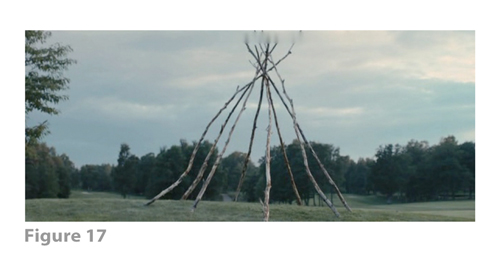
Of course, in this instance “as much as possible” is simply not good enough. The “forces of chaos” will break through in a moment, no matter what; and all “germinal” stirrings will soon be extinguished. But for Leo, and perhaps for the film’s audience as well, the magic cave does offer a kind of comfort. Leo feels solace, in much the same way that (as Deleuze and Guattari describe it) “a child in the dark, gripped with fear, comforts himself by singing under his breath… The song is like a rough sketch of a calming and stabilizing, calm and stable, center in the heart of chaos” (Deleuze and Guattari 1987, 311). Or, as Trevor Link puts it, the magic cave “suggests that in the face of what appears as utter hopelessness, there is a safe place, a sanctuary, where we can retreat and even draw others in for protection” (Link 2011).
What can we make of this sense of comfort and protection? The feeling is undeniable — even though we already know, as Justine does, that it is entirely illusory. The magic cave cannot actually avert the end of the world. Affectively speaking, the cave might even seem to hasten this end. As a kind of womb, or maternal shelter, the image of the cave resonates with the last tableau in the film’s Prologue, where the impact of Melancholia upon the Earth creates the appearance of an enormous breast. In the final shots of the film, Justine’s teepee almost seems like a magical focal point, drawing the planet Melancholia toward it. There is a deep ambivalence here, as the retreat to the maternal-feminine simultaneously seems to connote safety and annihilation. Justine embodies this ambivalence, as she works to protect Leo, while at the same time she accepts — and even welcomes — the oncoming disaster.
Justine comforts Leo in the same way that von Trier lulls and mollifies his audience: by creating a beautiful semblance (in German, a schöner Schein). I use this phrase, from Walter Benjamin, advisedly. For Benjamin argues that film is precisely the technology by means of which “art has escaped the realm of ‘beautiful semblance,’ which for so long was regarded as the only sphere in which it could thrive… The significance of ‘beautiful semblance’ is rooted in the age of auratic perception that is now coming to an end” (Benjamin 2008, 32). But in Melancholia, von Trier inverts Benjamin’s modernist narrative. He causes the cinematic apparatus to revert to its Romantic origins (think of Méliès!), when it was steeped in the magic of auratic perception, and in the fictions of the beautiful semblance.
If the magic cave at the end of Melancholia is a beautiful semblance, this means that it is a fictional construction, or a mimesis, that knows itself to be fictional and mimetic. The magic cave provides emotional support, not in spite of, but rather through, our awareness of its fictionality. Benjamin remarks that, “in mimesis, tightly interfolded like cotyledons, slumber the two aspects of art: semblance and play” (Benjamin 2008, 48). The ending of Melancholia incorporates both of these aspects. Leo is comforted, because Justine’s fabrication of the magic cave gives him a child’s opportunity to play: first by gathering sticks, and then by sitting carefully, with his eyes shut and holding Justine’s hand, within the circle that is defined by the teepee. And adult spectators can find the magic cave moving, precisely because we are so poignantly aware that it is a mere mimetic semblance. We know, as Justine does, how weak and limited a shelter it offers. We are drawn to the beautiful semblance on account of its very fragility and vulnerability, its ad hoc quality. Its value lies in its being fictive, and therefore having no actual utility.
Modernism has largely favored the sublime moment in Romantic aesthetics. But at least one strain of Romanticism affirms beauty instead, as a kind of anti-sublime. When we contemplate a beautiful semblance, we are not concerned with power, nor with ultimate truth. Kant’s theory of beauty, as I have argued elsewhere, is really a theory of singularity (Shaviro 2009, 1-16). For Kant, each appearance of beauty is entirely singular, since it cannot be subsumed under a concept or a rule. It exists entirely without warrant or guarantee. Where the sublime speaks in a voice of ultimate authority, the beautiful has no authority behind it. Beauty does not point us to anything beyond itself. Rather, Kant says, “we linger in our contemplation of the beautiful, because this contemplation reinforces and reproduces itself” (Kant 1987, 68; Ak 222 in the German text).
At most, Kant says, my contemplation of a beautiful semblance may involve a certain “attunement” of my mental powers, one that is determined “by feeling (rather than by concepts).” To the extent that other people also feel this mental attunement, we may share the experience of a beautiful semblance. At the limit, beauty has the potential to be “universally communicable” (Kant 1987, 87-88; Ak 238-239 in the German text). But this communicability is just a formal condition; it tells us nothing about any beautiful content in particular. This is why the contemplation of beauty is disinterested, according to Kant. Such contemplation has no concern for the actual existence of the thing that is beautiful (Kant 1987, 46; Ak 205 in the German text). The experience of beauty involves a pure semblance, which is not objectively grounded in any way.
Schopenhauer follows Kant in radically separating beauty from interest. But Schopenhauer, moving beyond Kant, further associates “interest” with the “will.” If the apprehension of beauty is disinterested, this means that it frees us from the burden and tyranny of willing. The experience of the beautiful involves “a state of pure contemplation, absorption in intuition, losing oneself in the object, forgetting all individuality, abolishing the mode of cognition that follows the principle of sufficient reason” (Schopenhauer 2010, 220; 232 in the German text). Against the “mode of cognition” that involves the will, and consists in the self-interested understanding of causes and effects, beauty leads to an entirely different sort of knowledge. Beauty “suddenly lifts us out of the endless stream of willing, tearing cognition from its slavery to the will” (Schopenhauer 2010, 220; 231 in the German text). When Justine tells Claire that she “knows things,” she is speaking in this transcendental sense, as what Schopenhauer calls a “pure, will-less subject of cognition” (Schopenhauer 2010, 219; 230 in the German text). Beauty, therefore, is something that wrenches us out of subjectivity, and takes us elsewhere. In menacing us, the sublime ends up by throwing us back upon ourselves. But the beautiful offers us a kind of release, a suspension of the will, a way out of ourselves. And this is why von Trier presents the end of the world as a seductively beautiful semblance.
The beautiful semblance at the end of Melancholia turns upon two figures in particular: that of the teepee, and that of the child. Like many other viewers of the film, I find these figures moving and comforting. They give us a basis for the mutual “attunement” of our feelings. By turning to Leo, and then by bringing Claire as well into the circle of the magic cave, Justine is able to share with them — or at least to communicate to them — her very sense of apartness, withdrawal, abandonment, and disinterest. And this sharing extends to the audience as well. The teepee and the child are figures, we might say, of a certain counter-identification. They allow for a kind of negative “universal communicability”: a communication without communion, a sharing of apartness, an experience of the extinction of all experience.
It is no accident, however, that these two figures — the teepee and the child — are both deeply problematic. If they work to console us, this is because they both connote the very sort of recuperation, or recovery from loss, that the film as a whole denounces as false. The teepee is a self-consciously exotic image; it suggests a kind of “primitive” oneness with nature, such as Western modernity has often attributed to traditional Native American cultures. Given the German Romantic references in Melancholia, we may think especially of Karl May’s “noble savages” in the American Wild West. The teepee implies a return, therefore, not just to the mother’s womb, but even more to the womb of Mother Nature herself, within which the native peoples of the Americas ostensibly lived in harmony. In this way, the teepee directly contradicts the grim truth that Justine knows: that “life on Earth is evil,” and that it will not be around for long.
As for Leo, because he is the only child in the movie, he cannot avoid standing in for what Lee Edelman calls reproductive futurism (Edelman 2004). Edelman shows how the figure of the Child “has come to embody for us the telos of the social order and come to be seen as the one for whom that order is held in perpetual trust.” There is always a Child who must be protected from anything that might disturb its alleged “innocence,” and who thereby represents the dream of a purified future. Desire is policed, and nonreproductive sexuality is stigmatized, in deference to a “fantasy of the future” that never actually arrives (Edelman 2004, 11). Justine implicitly gestures to this “fantasy of the future” when she cares for Leo — in a way that she is unwilling to do for Claire, or for any other adults. In Melancholia, this invocation of the futurity figured in the Child comes precisely, and contradictorily, when there is no futurity left. There is literally no future for the sake of which we might hope for Leo to survive and grow.
The Child figures a fantasmatic future, just as the teepee figures a fantasmatic past. I think that both of these figures have such a poignant effect upon me — and upon so many other viewers of Melancholia — precisely because they are presented to us at the point of their abolition. They are annihilated, together with the ultra-bourgeois, luxurious lifestyle in which they are embedded. For von Trier, the logic of capitalist realism remains intact. There is no question, in his films, of showing us another way of life, another organization either of economic relations or of sexual desire. But in confronting us with the literal truth of extinction, the film pushes modernist self-consciousness, reproductive futurism, and capital accumulation to ther degree zero, to the point of their exhaustion.
In the final moments of Melancholia, everything is staked on a fantasy of primitivism when this fantasy is no longer able to operate. Everything is focused on the prospects of the male child, precisely at the moment when he has no future, and when the telos for which he might previously have stood is abrogated once and for all. And everything is confined to the microcosm of John’s estate, because this self-enclosed place is a kind of endpoint of capital accumulation: a hoard of appropriated value that now can neither be saved and invested, nor spent and enjoyed. We have come to the end of everything that modernist Western culture has defined as normatively “human.” And in this wreckage, in this erasure of the social order, in this emptying-out of all futurity and all usefulness, we find the emergence of unalloyed Beauty.
Melancholia ends by showing us the completed “magic cave.” Justine escorts both Leo and Claire over the threshold of the teepee structure, and inside. The three of them sit in a circle as they wait. The blue sphere of Melancholia approaches from behind them, getting larger and larger [Figure 18, below]. There is a great whooshing sound, layered over yet another repetition of the Prelude to Tristan. In these final moments, Claire has entirely lost control; she sits there bitterly weeping. Leo sits calmly, with his eyes closed and holding Justine’s hand, just as she has told him to. Justine herself displays a stoic resignation, as she sits facing away from the onrushing planet. At the final moment, Tristan cuts out, the whooshing sound gets louder, and everything is obliterated in a blinding flash of white. After this, the whooshing sound cuts out as well, and there is an abrupt cut to black. It’s all over. The credits begin to roll, in total silence.
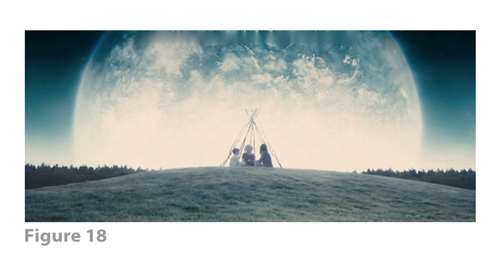
Thinking back on Melancholia, I most vividly remember its moments of sheer, gratuitous beauty: the tableaux of the prologue, the shots of the planet Melancholia glistening in the sky, the images of Justine naked in the Melancholia-light. But there is one shot, close to the end of the film, that haunts me even more. Justine and Leo have just been gathering sticks in the woods. As they move on, we get an extreme closeup of Justine’s boot, and then of the footprint that it leaves on the forest floor. There is no other shot like this in the whole length of the film. Worms wriggle in the earthy depression, and insects scurry about in the soil [watch the 6 second-long sequence, below]. The shot suddenly gives us entry to another dimension, and lets us see on another scale of vision. We are immersed for a moment in a micro-realm, one that is altogether beyond or beneath the human. These worms and bugs are also about to die, although they probably do not know it. But each of these creatures has its own needs, its own desires, its own values, and its own concerns. We are exposed to the beauty, and the “evil,” of a Nature that does not belong to us, and that is not to our own measure. What, we may wonder, do the denizens of this Nature feel?
SUGGESTED CITATION
Shaviro, Steven, ‘MELANCHOLIA, or, The Romantic Anti-Sublime’, Sequence, 1.1, 2012. Online at: https://reframe.sussex.ac.uk/sequence1/1-1-melancholia-or-the-romantic-anti-sublime/
COPYRIGHT NOTICE
STEVEN SHAVIRO, the copyright holder of the above work, shares it here under a Creative Commons Attribution-ShareAlike 3.0 Unported License (CC BY-SA 3.0). In any future uses of the work, please also acknowledge Sequence, 1.1, 2012 as its first place of publication.
All images from Melancholia reproduced above derive from frame grabs (and one 6 second sequence) excerpted from the DVD version of the film: © 2011 Zentropa Entertainments27 ApS, Memfis Film International AB, Zentropa International Sweden AB, Slot Machine SARL, Liberator Productions SARL, Arte France Cinéma, Zentropa International Köln GmbH. DVD: Magnolia Home Entertainment. They appear here solely for Fair Dealing (and Fair Use) purposes of scholarship and criticism.
FILMOGRAPHY
2001: A Space Odyssey (Stanley Kubrick, 1968)
2012 (Roland Emmerich, 2009)
24 (TV series: Imagine Entertainment, 20th Century Fox Television, Real Time Productions, Teakwood Lane Productions, 2001-2010)
L’Année dernière à Marienbad/Last Year At Marienbad (Alain Resnais, 1961)
Antichrist (Lars von Trier, 2009)
Armageddon (Michael Bay, 1998)
Breaking the Waves (Lars von Trier, 1996)
Dancer in the Dark (Lars von Trier, 2000)
Direktøren for det hele/The Boss of It All (Lars von Trier, 2006)
Dogville (Lars von Trier, 2003)
Festen/The Celebration (Thomas Vinterberg, 1998)
Forbrydelsens element/The Element of Crime (Lars von Trier, 1984)
Idioterne/The Idiots (Lars von Trier, 1998)
Irréversible/Irreversible (Gaspar Noé, 2002)
Manderlay (Lars von Trier, 2005)
Melancholia (Lars von Trier, 2011)
Peeping Tom (Michael Powell, 1960)
Solyaris/Solaris (Andrei Tarkovsky, 1972)
Srpski film/A Serbian Film (Srđan Spasojević, 2010)
Titanic (James Cameron, 1997)
WORKS CITED
Althusser, Louis (2006). For Marx. Trans. Ben Brewster. New York: Verso.
Benjamin, Walter (2008). The Work of Art in the Age of Its Technological Reproducibility, and Other Writings on Media. Cambridge: The Belknap Press of Harvard University Press.
Brassier, Ray (2007). Nihil Unbound: Enlightenment and Extinction. New York: Palgrave Macmillan.
Brassier, Ray (2010). “Concepts and Objects”. In: Bryant, Levi, Nick Srnicek, and Graham Harman, eds., The Speculative Turn: Continental Materialism and Realism. Melbourne: re.press, 47-65.
Brassier, Ray (2011). “I am a nihilist because I still believe in truth”. Interview by Marcin Rychter. Available online at http://www.kronos.org.pl/index.php?23151,896 (last accessed August 25, 2012).
Carlsen, Per Jull (2011). “The Only Redeeming Factor is the World Ending,” interview with Lars von Trier. Available online at http://www.dfi.dk/Service/English/News-and-publications/FILM-Magazine/Artikler-fra-tidsskriftet-FILM/72/The-Only-Redeeming-Factor-is-the-World-Ending.aspx (last accessed August 25, 2012).
Clover, Carol (1993). Men, Women, and Chain Saws: Gender in the Modern Horror Film. Princeton: Princeton University Press.
Dargis, Manohla (2011). “This Is How The End Begins.” The New York Times, December 30, 2011. Available online at http://www.nytimes.com/2012/01/01/movies/awardsseason/manohla-dargis-looks-at-the-overture-to-melancholia.html (last accessed August 25, 2012).
Deleuze, Gilles, and Felix Guattari (1987). A Thousand Plateaus: Capitalism and Schizophrenia. Trans. Brian Massumi. Minneapolis: University of Minnesota Press.
Edelman, Lee (2004). No Future: Queer Theory and the Death Drive. Durham: Duke University Press.
Fisher, Mark (2009). Capitalist Realism: Is There No Alternative?. Winchester: Zero Books.
Fox, Dominic (2009). Cold World: The Aesthetics of Dejection and the Politics of Militant Dysphoria. Winchester: Zero Books.
Harman, Graham (2011). The Quadruple Object. Winchester: Zero Books.
Heidegger, Martin (1996). Being and Time. Trans. Joan Stambaugh. Albany: SUNY Press.
Kant, Immanuel (1987). Critique of Judgment. Trans. Werner S. Pluhar. Indianapolis: Hackett.
Link, Trevor (2011). “Depression, Melancholia, and Me: Lars von Trier’s Politics of Displeasure.” Available online at http://occupiedterritories.tumblr.com/post/13114178124/depression-melancholia-and-me-lars-von-triers (last accessed August 25, 2012) .
Meillassoux, Quentin (2008). After Finitude: An Essay on the Necessity of Contingency. Trans. Ray Brassier. New York: Continuum.
Nietzsche, Friedrich (2005). The Anti-Christ, Ecce Homo, Twilight of the Idols: And Other Writings. New York: Cambridge University Press.
Nietzsche, Friedrich (2006). * ‘On the Genealogy of Morality’ and Other Writings*. New York: Cambridge University Press.
Ross, Alex (2011). “Melancholia, Bile.” Available online at: http://www.therestisnoise.com/2011/11/melancholia-bile.html (last accessed August 25, 20120).
Schopenhauer, Arthur (2007). The Art of Controversy. New York: Cosimo.
Schopenhauer, Arthur (2010). The World as Will and Representation, Volume 1. Trans. Judith Norman, Alistair Welchman, and Christopher Janaway. New York: Cambridge University Press.
Shaviro, Steven (2009). Without Criteria: Kant, Whitehead, Deleuze, and Aesthetics. Cambridge: MIT Press.
Shaviro, Steven (2010). Post-Cinematic Affect. Winchester: Zero Books.
Taubin, Amy (2011). “Naught So Sweet.” Artforum 50:2, October 2011.
Thacker, Eugene (2011). In the Dust of This Planet. Winchester: Zero Books.
Thorsen, Nils (2011). “Longing for the End of It All.” Interview with Lars von Trier in Melancholia Press Kit. Available online at http://www.melancholiathemovie.com/#_interview (last accessed August 25, 2012) .
von Trier, Lars (2011). “A Beautiful Movie About the End of the World”, Director’s Statement in Melancholia Press Kit. Available online at http://www.melancholiathemovie.com/#_directorsstatement (last accessed August 25, 2012).
White, Rob, and Nina Power (2011). “Lars von Trier’s Melancholia: A Discussion.” Available online at http://www.filmquarterly.org/2012/01/lars-von-triers-melancholia-a-discussion/ (last accessed August 25, 2012).
World of Warcraft Wiki. “Steelbreaker.” Available online at http://www.wowwiki.com/Steelbreaker (last accessed August 26, 2012).
Žižek, Slavoj (2006). The Parallax View. Cambridge: MIT Press.

Pingback: Required Reading: Shaviro on Melancholia | initiative für interdisziplinäre medienforschung